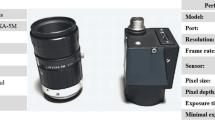Abstract
In order to obtain the target information in the test area accurately, a polarization spectrum imaging system is designed, and a target recognition algorithm based on gray feature extraction is proposed. The system adopts laser, polarization analyzer, CCD, and processing module. The rapid identification of the target is accomplished by obtaining the spectral information of different polarization states. The laser acquisition optical system is designed, including the collimation module and the focusing module. The experiment calculates the target recognition probability under the condition of different number of features. The experimental results show that at 0.5 km, there is little difference in the number of different characteristic wavelengths, and the recognition probability is above 99.5%. After more than 1 km, with the increase of the number of characteristic wavelengths, the recognition probability is relatively high, but the overall results are above 95%. It can be seen that the algorithm has a good recognition effect and has certain application value.
Access this chapter
Tax calculation will be finalised at checkout
Purchases are for personal use only
Similar content being viewed by others
References
Shi M, Wu Z, Li J et al (2022) High-power narrow-linewidth fiber lasers using optical spectrum broadening based on high-order phase modulation of inversion probability-tuning sequence. Opt Express 30(6):8448–8460
Imgram P, König K, Krämer J et al (2020) High-precision collinear laser spectroscopy at the collinear apparatus for laser spectroscopy and applied physics (COALA). Hyperfine Interact 241(1):014017–014180
Damodaram D, Venkateswarlu T (2019) FPGA implementation of genetic algorithm to detect optimal user by cooperative spectrum sensing. ICT Express 5(4):245–249
Kudryashov SI, Danilov PA, Sdvizhenskii PA et al (2022) Transformations of the spectrum of an optical phonon excited in Raman scattering in the bulk of diamond by ultrashort laser pulses with a variable duration. JETP Lett 115(5):251–255
Islam MN, Akhter H (2019) Study of FPGA based multi-channel analyzer for Gamma ray and X ray spectrometry. Int J Trend Sci Res Dev 3(3):61–65
Gupta N, Suhre DR (2007) Acousto-optic tunable filter imaging spectrometer with full stokes polarimetric capability. Appl Opt 46(14):2632–2637
Xu J, Xi N, Zhang C et al (2011) Real-time 3D shape inspection system of automotive parts based on structured light pattern. Opt Laser Technol 43(1):1–8
Barone S, Paoli A, Razionale AV (2012) Shape measurement by a multi-view methodology based on the remote tracking of a 3D optical scanner. Opt Lasers Eng 50(3):380–390
Liu X, Heifetz A, Tseng SC et al (2009) High-speed inline holographic stokesmeter imaging. Appl Opt 48(19):3803–3808
Vrushaly S, John Z, Curtis M (2022) Continuous spectrum of periodically stationary pulses in a stretched-pulse laser. Opt Lett 47(6):1490–1493
He G, Shi P, Zhang D et al (2020) Stiffness matching method for the ball screw feed drive system of machine tools. J Mech Sci Technol 34(8):2985–2995
Aslam M, Ul Haq I, Rehan MS et al (2021) Health analysis of transformer winding insulation through thermal monitoring and fast Fourier transform (FFT) power spectrum. IEEE Access 9(1):114207–114227
Pogoda AP, Petrov VM, Khakhalin IS et al (2022) Intra-Cavity holographic gratings and lasers with a controllable spectrum based on them. Opt Spectrosc 129(12):1321–1326
He S, Jian G, Chen D et al (2021) A fusion approach for suppression of environmental noise in spread spectrum induced polarization data. Pure Appl Geophys 178(9):1–10
Author information
Authors and Affiliations
Corresponding author
Editor information
Editors and Affiliations
Rights and permissions
Copyright information
© 2023 The Author(s), under exclusive license to Springer Nature Singapore Pte Ltd.
About this paper
Cite this paper
Chen, X. et al. (2023). Target Recognition Algorithm Based on Polarization Spectral Imaging. In: Jansen, B.J., Zhou, Q., Ye, J. (eds) Proceedings of the 2nd International Conference on Cognitive Based Information Processing and Applications (CIPA 2022). CIPA 2022. Lecture Notes on Data Engineering and Communications Technologies, vol 155. Springer, Singapore. https://doi.org/10.1007/978-981-19-9373-2_61
Download citation
DOI: https://doi.org/10.1007/978-981-19-9373-2_61
Published:
Publisher Name: Springer, Singapore
Print ISBN: 978-981-19-9372-5
Online ISBN: 978-981-19-9373-2
eBook Packages: Intelligent Technologies and RoboticsIntelligent Technologies and Robotics (R0)




